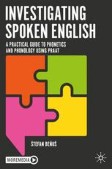Search
Search Results
-
Haptic Prosody and the Aesthetics of Baby Books
While touch is the first sense to develop in the fetus, it has often been overlooked as the effective base of aesthetics and poetics in baby books....
-
Punctuation: a missing link between awareness of prosody and reading comprehension
There is growing theoretical and empirical consensus for a role of awareness of suprasegmental phonology, also known as prosody, or the rhythmic...

-
Prosody
‘Prosody’ encompasses phenomena related to aspects of speech such as melody, rhythm, stress, phrasing, pauses, and voice quality. These are related...
-
The effect of a reading aloud program on reading rate and reading prosody in a group of sixth-grade low-achievement, language-minority, and/or low-SES readers
The purpose of this study was to investigate if a group of sixth-grade low achievement language minority (LM) students’ reading skills could be...

-
Perception Correlated Information Allocation and Pattern Convergence for Discourse Prosody
This chapter will present a study that explored speech expressiveness and information arrangement in relation to discourse prosody in continuous...
-
Focus without pitch boost: focus sensitivity in Japanese why-questions and its theoretical implications
Unlike typical wh-questions, why -questions are known to be focus-sensitive, but the linguistic realization of their focus sensitivity shows an...

-
Corpora compilation for prosody-informed speech processing
Research on speech technologies necessitates spoken data, which is usually obtained through read recorded speech, and specifically adapted to the...

-
Prosody as syntactic evidence
A subset of Mayan languages feature “prosodic allomorphy,” a phenomenon involving morphological alternations at certain prosodic boundaries. In...

-
Towards a theory of morphosyntactic focus marking
Based on six detailed case studies of languages in which focus is marked morphosyntactically, we propose a novel formal theory of focus marking,...

-
The prosody of Spanish acronyms
This paper presents a first attempt to formally characterize the prosodic properties of Spanish acronyms. Based on the examination of a dataset and...

-
On the roles of anaphoricity and questions in free focus
The sensitivity of focus to context has often been analyzed in terms of focus-based anaphoric relations between sentences and surrounding discourse....

-
Prosody III: Beyond Intonational Phrase
The chapter is unique in covering ground commonly neglected in other textbooks in this topic. It discusses several patterns of how prosody signals...
-
Floating quantifiers, specificity and focus in Lalo Yi
Lalo Yi presents a distribution of numeral-classifier pairs that appears to be the complete inverse of the norm found in other numeral-classifier...

-
On the absence of low focus movement in Brazilian Portuguese
A number of works have assumed the existence of so-called “low focus movement” in Brazilian Portuguese, that is, focus-driven movement to a...

-
Word Stress Prosody in the Spontaneous Declarative Utterances of Threshold Level Hungarian Learners of Spanish
One of the most challenging areas of language acquisition for Hungarian learners of Spanish is prosody. The purpose of the paper is to validate the...
-
Prosody II: Intonation
This chapter reviews ways of describing intonational contours expanding on the characteristics of boundaries and accents introduced in Chapter...
-
Reconsidering multiple scrambling in Japanese
This paper reconsiders the syntax of Multiple Scrambling in Japanese taking its prosodic patterns into consideration. Specifically, the paper...

-
Dress to Impress? On the Interaction of Attire with Prosody and Gender in the Perception of Speaker Charisma
Understanding charismatic speech becomes a highly relevant issue in times of globalized markets and mobile on-demand mass media that strengthen the...
-
Silence as Masquerade: Punctuation, Prosody, and Performance in “A Primer for the Punctuation of Heart Disease”
This chapter models a method for reading written silence as a masquerade. As I propose here, in order to recognise and then to attempt to record it...
-
A review of reading prosody acquisition and development
The present work reviews the current knowledge of the development of reading prosody, or reading aloud with expression, in young children. Prosody...

